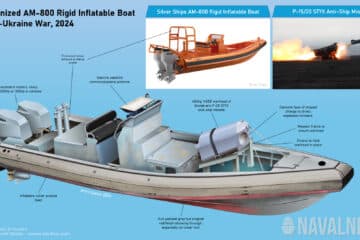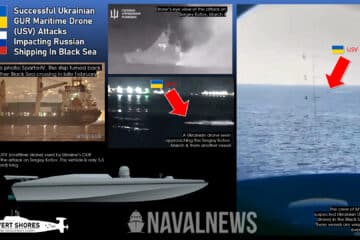A small parcel of land on the southeast corner of the Baltic, the Russian exclave of Kaliningrad is suddenly in the spotlight. Cut off from Russia, its overland supply lines have always been fragile. They principally run through the EU and NATO state of Lithuania. Now Lithuania is implementing EU sanctions which restrict this route. It is a potential flashpoint for a Russia-NATO conflict.
Analysis of satellite imagery shows that Russia has now positioned advanced anti-ship missiles on the Kaliningrad coast.
The systems are deployed to the Mys Taran headland, a prominent landmark mid-way along the exclave’s short coastline.
Terrible Twins: Bal & Bastion
The missile systems are two types which are often deployed together. The first, 3K60 Bal system (NATO: SSC-6 Sennight), is loosely equivalent to the Harpoon. It shoots the Kh-35 missile, known by the NATO reporting name SS-N-25 Switchblade. This is the same missile that Ukraine’s Neptune system is based on. Each Bal TEL (transporter erector launcher, read ‘launch truck’) can carry 8 missiles. This is more than most other comparable coastal defense systems.
Bal has an effective range of around 70 nautical miles, with an improved version increasing this to 160 nautical miles.
The Bal system is a subsonic sea-skimming missile. Although the sinking of Russia’s Black Sea flagship, Moskva, by Neptune missiles is proof of the usefulness of this category of system, in Kaliningrad it is complemented by something even ore deadly: Bastion-P.
The K-300P Bastion-P (NATO: SSC-5 Stooge) is the land-based variant of the P-800 Oniks (NATO: SS-N-26 Strobile). This system has a longer range than Bal, around 190 nautical miles, and flies at Mach 2.5. A top-tier weapon of the post Cold War era, it is considered a serious threat to any surface vessel.
Bastion-P also has a land attack cruise missile capability. This is how it has been used in the Ukraine War. Being large and expensive it is however less optimal than the main Russian cruise missile, Kalibr. That system is carried by several of Russia’s Baltic Fleet warships.
Bastion-P and Bal are often seen deployed together in Kaliningrad, sharing the same Monolith-B target acquisition radar. On paper the various elements of the system could be well dispersed to increase survivability. But in practice they are observed close together in a somewhat traditional arrangement.
Strategic Context
The range of these missiles, particularly Bastion-P, reaches all the way to the Swedish coast on the other side of the Baltic. Long range engagements would depend on suitable targeting information.
Although there is no secret that Russia has these systems in Kaliningrad, they are being deployed during a time of heightened tensions.
Defense analyst Benjamin Pittet believes that Russia is using it more than ever as a means of pressure on the West. “We saw this with the deployment of Kinzhal ballistic missiles a few days before the invasion of Ukraine.” He added that the current deployment may be to influence Lithuania which is implementing sanctions.
Political rhetoric on the Russian side has promised retaliation against Lithuania. Nikolai Patrushev, secretary of Russia’s Security Council, said that measures would be implemented. “…will certainly respond to such hostile actions”. He was quoted as saying. “Their consequences will have a serious negative impact on the population of Lithuania.”
Anti-ship missiles are unlikely to be the primary response to Lithuania. The tiny Baltic state is a member of NATO, so any attack would be a major escalation. But their positioning paints a picture, and is typical of Russia’s posturing in the exclave.






